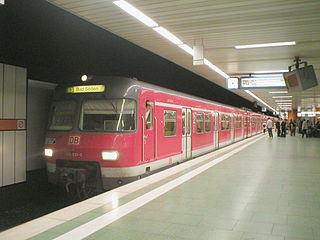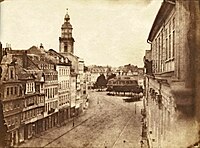
Frankfurt am Main is the most populous city in the German state of Hesse. Its 773,068 inhabitants as of 2022 make it the fifth-most populous city in Germany. Located in the foreland of the Taunus on its namesake Main, it forms a continuous conurbation with Offenbach am Main; its urban area has a population of over 2.7 million. The city is the heart of the larger Rhine-Main metropolitan region, which has a population of more than 5.8 million and is Germany's second-largest metropolitan region after the Rhine-Ruhr region and the fourth biggest metropolitan region by GDP in the European Union. Frankfurt is home to the European Central Bank, one of the institutional seats of the European Union, while Frankfurt's central business district lies about 90 km (56 mi) northwest of the geographic center of the EU at Gadheim in Lower Franconia. Like France and Franconia, the city is named after the Franks. Frankfurt is the largest city in the Rhenish Franconian dialect area.

Alte Oper is a concert hall in Frankfurt am Main, Hesse, Germany. It is located in the inner city, Innenstadt, within the banking district Bankenviertel. Today's Alte Oper was built in 1880 as the city's opera house, which was destroyed by bombs in 1944. It was rebuilt in the 1970s as a concert hall with a large hall and smaller venues, opened in 1981. The square in front of the building is still known as Opernplatz.

The Innenstadt is the central city district of Frankfurt am Main, Germany. It is part of the Ortsbezirk Innenstadt I. Its western part forms part of Frankfurt's central business district, the Bankenviertel. Germany's most expensive shopping streets and real estate are found within the city district.

The Frankfurt U-Bahn is a Stadtbahn (premetro) system serving Frankfurt, Germany. Together with the Rhine-Main S-Bahn and the tram network, it forms the backbone of the public transport system in Frankfurt. Its name derives from the German term for underground railway, Untergrundbahn. Since 1996, the U-Bahn has been owned and operated by Stadtwerke Verkehrsgesellschaft Frankfurt am Main (VGF), the public transport company of Frankfurt, and is part of the Rhein-Main-Verkehrsverbund (RMV) transport association. The licence contract is up to 31 December 2031 and is renewable. The contracting authority of VGF is the municipal transport company traffiQ.

The Zeil is a street in the city centre of Frankfurt, Germany. The name, which dates back to the 14th century, is derived from the German word Zeile "row" and originally referred to a row of houses on the eastern end of the north side; the name was not extended to the entire street until later.

The Rhine-Main S-Bahn system is an integrated rapid transit and commuter train system for the Frankfurt/Rhine-Main region, which includes the cities Frankfurt am Main, Wiesbaden, Mainz, Offenbach am Main, Hanau and Darmstadt. The network comprises nine S-Bahn lines, eight of which currently travel through the cornerstone of the system, a tunnel through central Frankfurt. The first section of this tunnel was opened on May 28, 1978. Further tunnel sections were opened in 1983 and 1990, before its completion in 1992. The system belongs to the Rhein-Main-Verkehrsverbund (RMV) and is operated by DB Regio, a subsidiary of Deutsche Bahn.
The B Line is the second line in the network of the Frankfurt U-Bahn, running in a west–east direction from the central railway station (Hauptbahnhof) through the old town to Konstablerwache, where it splits into two branches to Bornheim and Preungesheim. Originally planned as an independent main line, part of the D Line forms an extension of U4 to Bockenheimer Warte from the central railway station.

The Frankfurt am Main tramway network is a network of tramways forming a major part of the public transport system in Frankfurt am Main, a city in the federal state of Hesse, Germany.

The S5 service of the S-Bahn Rhein-Main system bearing the KBS number 645.5

The Frankfurt City Tunnel is a standard gauge railway in Frankfurt and the core of the Rhine-Main S-Bahn. The line runs underground for its entire length.

Frankfurt (Main) Hauptbahnhof is a four-track S-Bahn station below Frankfurt (Main) Hauptbahnhof and as such part of the busiest railway station in Frankfurt, Germany. It is also the busiest rapid transit station in Frankfurt.

Frankfurt (Main) Hauptwache station is a major train station situated at the Hauptwache square in the centre of Frankfurt, Germany.

Frankfurt am Main Konstablerwache station is a major train station and metro station at the Konstablerwache square in the city centre of Frankfurt am Main, Germany.

Konstablerwache is a square in the centre of Frankfurt am Main and part of the city's pedestrian zone. It lies to the east of Hauptwache with both squares linked by the Zeil, the central shopping street of the city.

The C Line is the third line of the Frankfurt U-Bahn. It opened on 11 October 1986 and runs east-west through the city centre via Hauptwache and Konstablerwache. In the East it has branches to Frankfurt Ost railway station and Enkheim. To the North-west of the city centre it runs under Bockenheimer Landstraße before splitting into two branches to Hausen and Praunheim. The main services on the line are the U6 and U7 (Praunheim-Enkheim). Part of the branch to Enkheim also carries U4 services.

Niedernhausen station serves the municipality of Niedernhausen in the German state of Hesse. It is the most important station on the Main-Lahn Railway between the stations of Frankfurt-Höchst and Eschhofen in Limburg an der Lahn. It is the terminus of the Ländches Railway running from Niedernhausen to Wiesbaden Hauptbahnhof and of line S2 of the Rhine-Main S-Bahn from Frankfurt.

Frankfurt-Frankfurter Berg station is a railway station located in the Frankfurter Berg district of Frankfurt, Germany. The station is classified by Deutsche Bahn as a category 5 station and part of the Main–Weser Railway. The station was called Bonames until 1996.

Freßgass is an upmarket shopping street in the city centre of Frankfurt, Germany, located in the district of Innenstadt and within the central business district known as the Bankenviertel. It is commonly regarded as Frankfurt's culinary main street. The street is a broad pedestrian zone, and is located between Hochstraße and the Opernplatz with the Alte Oper in the west and the Börsenstraße with the Frankfurt Stock Exchange in the east. The street is also the direct continuation of the Zeil, and is a parallel street of Goethestraße, Germany's best known luxury shopping street. In recent years Freßgass has increasingly become a luxury shopping street, serving as an extension of the Goethestraße in this regard. Its other primary adjacent street is the Kaiserhofstraße.

Broadcasting House Dornbusch is headquarters and main broadcasting facility of the German public broadcaster for the state of Hessen, Hessischer Rundfunk.

FRTC Frankfurt is a firefighting training facility at Eckenheim in Frankfurt am Main, Germany. It is notable for having its own standard gauge rail system and mock-Frankfurt U-Bahn underground station.

























